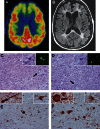CSF1R mutations link POLD and HDLS as a single disease entity
- PMID: 23408870
- PMCID: PMC3653204
- DOI: 10.1212/WNL.0b013e31828726a7
CSF1R mutations link POLD and HDLS as a single disease entity
Abstract
Objective: Pigmented orthochromatic leukodystrophy (POLD) and hereditary diffuse leukoencephalopathy with axonal spheroids (HDLS) are rare neurodegenerative disorders characterized by cerebral white matter abnormalities, myelin loss, and axonal swellings. The striking overlap of clinical and pathologic features of these disorders suggested a common pathogenesis; however, no genetic or mechanistic link between POLD and HDLS has been established. Recently, we reported that mutations in the colony-stimulating factor 1 receptor (CSF1R) gene cause HDLS. In this study, we determined whether CSF1R mutations are also a cause of POLD.
Methods: We performed sequencing of CSF1R in 2 pathologically confirmed POLD families. For the largest family (FTD368), a detailed case report was provided and brain samples from 2 affected family members previously diagnosed with POLD were re-evaluated to determine whether they had HDLS features. In vitro functional characterization of wild-type and mutant CSF1R was also performed.
Results: We identified CSF1R mutations in both POLD families: in family 5901, we found c.2297T>C (p.M766T), previously reported by us in HDLS family CA1, and in family FTD368, we identified c.2345G>A (p.R782H), recently reported in a biopsy-proven HDLS case. Immunohistochemical examination in family FTD368 showed the typical neuronal and glial findings of HDLS. Functional analyses of CSF1R mutant p.R782H (identified in this study) and p.M875T (previously observed in HDLS), showed a similar loss of CSF1R autophosphorylation of selected tyrosine residues in the kinase domain for both mutations when compared with wild-type CSF1R.
Conclusions: We provide the first genetic and mechanistic evidence that POLD and HDLS are a single clinicopathologic entity.
Figures



References
-
- Marotti JD, Tobias S, Fratkin JD, Powers JM, Rhodes CH. Adult onset leukodystrophy with neuroaxonal spheroids and pigmented glia: report of a family, historical perspective, and review of the literature. Acta Neuropathol 2004;107:481–488 - PubMed
-
- Hanaya R, Arita K, Itoh Y, Kiura Y, Iida K, Kurisu K. Zygomatic osteotomy for resection of medial temporal cavernous angioma in dominant hemisphere after subdural grid electroencephalographic study. Hiroshima J Med Sci 2006;55:39–43 - PubMed
Publication types
MeSH terms
Substances
Grants and funding
LinkOut - more resources
Full Text Sources
Other Literature Sources
Medical
Molecular Biology Databases
Research Materials
Miscellaneous
